"Cherishing Little Steps - A Haven for Baby and Family Journeys"
Baby Shoes for New Walkers
Step into the world of walking with confidence and style as we explore the essential guide to baby shoes for new walkers.
Like a guiding light on a path, these tiny shoes play a crucial role in supporting and protecting those precious little feet.
From choosing the right size to understanding the benefits of soft-soled shoes, we will delve into the world of supportive features, stylish options, and proper fit.
Join us as we unlock the secrets to keeping your little one comfortable and fashionable every step of the way.
Key Takeaways
- Proper measurement is essential for comfort and foot development.
- Soft-soled shoes promote natural foot movement, balance, and coordination.
- Consider brand reputation, quality of materials, and design features when choosing baby shoes.
- Budget-friendly options for baby shoes include consignment stores, garage sales, online parenting communities, and thrift stores.
Choosing the Right Size
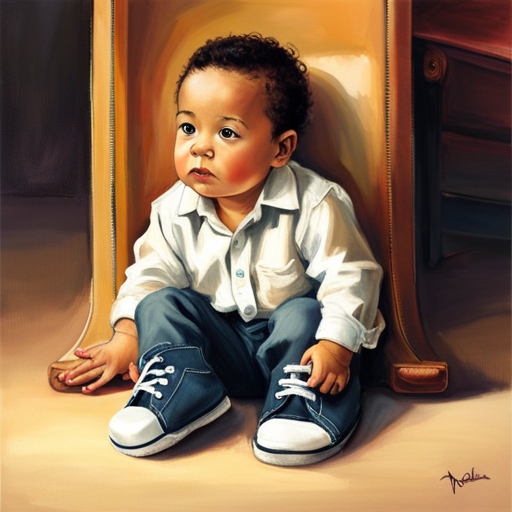
Selecting the appropriate shoe size is crucial when considering the comfort and proper foot development of new walkers. Proper measurement is essential to ensure that the shoes fit well and provide the necessary support for their growing feet. It is important to measure both the length and width of the foot to find the perfect fit.
To measure the length, place the baby’s foot on a piece of paper and mark the heel and the longest toe. Measure the distance between these two points to determine the length. For the width, measure the widest part of the foot. These measurements will help in selecting the right shoe size.
In addition to proper measurement, it is also important to consider a growth allowance when choosing shoes for new walkers. Babies’ feet grow rapidly, and it is recommended to leave some room for growth. A thumb’s width between the longest toe and the front of the shoe is a good rule of thumb.
Types of Baby Shoes
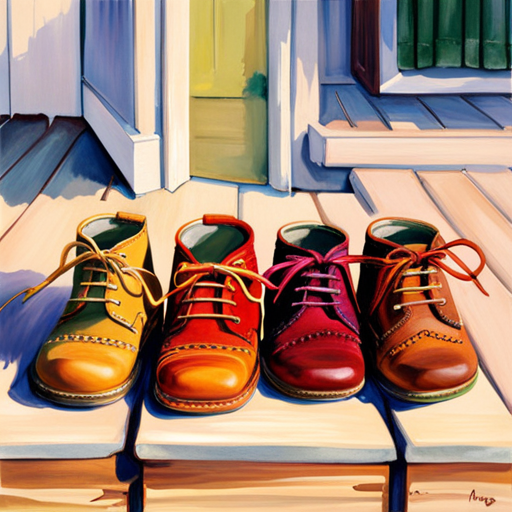
There are several popular brands that offer a wide range of cute and durable baby shoes for new walkers. These brands understand the importance of providing comfortable shoes that support the development of a child’s feet. Some of the top baby shoe brands include Nike, Adidas, Stride Rite, and Robeez.
Nike and Adidas are known for their athletic footwear, and they offer baby shoes that are designed with the same quality and attention to detail as their adult shoes. These brands offer a variety of styles and colors to choose from, including popular colors such as pink, blue, and gray.
Stride Rite is a brand that specializes in children’s footwear, and they have been trusted by parents for many years. They offer a range of baby shoes that are not only stylish but also provide the necessary support for new walkers. Stride Rite shoes come in a variety of colors, including classic white, as well as fun and vibrant shades.
Robeez is a brand that focuses on providing soft-soled shoes for babies and toddlers. Their shoes are made from high-quality materials that allow for natural movement and flexibility. They offer a variety of cute and playful designs, with popular colors like yellow, green, and red.
When choosing baby shoes, it is important to consider the brand’s reputation, the quality of materials used, and the design features that will best support your child’s feet. Additionally, selecting shoes in popular colors can add a fun and fashionable touch to your little one’s wardrobe.
Benefits of Soft-Soled Shoes
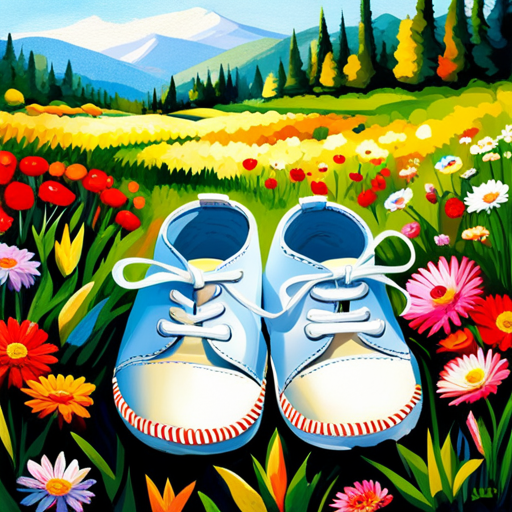
Soft-soled shoes are highly recommended for new walkers due to their flexibility and ability to promote natural foot movement. Interestingly, pediatricians often advise parents to opt for these types of shoes as they allow for better balance and coordination. Soft-soled shoes provide a comfortable fit, allowing the baby’s feet to move and grow naturally. This is crucial for proper foot development.
When babies start to walk, their feet are still developing and are more susceptible to pressure and stress. Soft-soled shoes offer a lightweight and flexible option that mimics barefoot walking, allowing the foot muscles to strengthen and the arches to develop naturally. The soft sole also provides some protection from rough surfaces and potential hazards while still allowing the foot to move freely.
Additionally, soft-soled shoes promote better balance and coordination. The flexibility of the shoe allows the baby to feel the ground beneath their feet, improving their proprioception and spatial awareness. This, in turn, helps them to develop better balance and coordination skills as they learn to navigate their surroundings.
Supportive Features to Look For

Parents should carefully consider the supportive features to look for in baby shoes, as these features play a crucial role in promoting proper foot development and ensuring the baby’s comfort while walking. When selecting baby shoes, it is important to choose the right size. Sizing tips include measuring the length and width of the baby’s foot, and selecting shoes that provide enough space for growth. Shoes that are too tight can restrict movement and hinder proper foot development.
Another important factor to consider is the flexibility of the shoes. Babies’ feet are still developing, and they need shoes that allow natural movement. Flexible shoes with a soft sole enable the baby to feel the ground and develop balance and coordination. Look for shoes made from materials like leather or cloth, as they tend to be more flexible than rigid materials like plastic or rubber.
In addition to sizing and flexibility, it is also important to consider other supportive features such as a cushioned insole, a secure closure system, and a padded heel collar. These features provide additional comfort and support to the baby’s feet while walking.
Overall, choosing the right supportive features in baby shoes is essential for promoting proper foot development and ensuring the baby’s comfort. By considering sizing tips and the importance of flexibility, parents can make informed decisions and provide their babies with the best possible shoes for their growing feet.
Stylish Options for Fashionable Walkers
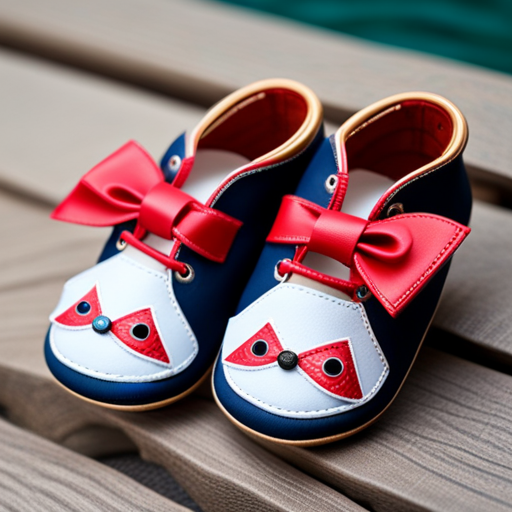
What stylish options are available for fashionable walkers looking for trendy baby shoes? When it comes to dressing up your little one, trendy designs and matching accessories are a must. Baby shoes not only protect their delicate feet but can also be a fashion statement. Let’s explore some stylish options for fashionable walkers.
| Brand | Style | Matching Accessories |
|---|---|---|
| Mini Fashion | Sneakers | Headbands |
| Little Steps | Mary Janes | Bowties |
| Trendy Tots | Booties | Socks |
| Tiny Toes | Sandals | Sunglasses |
Mini Fashion offers trendy sneakers for your stylish walker, and they can be paired with adorable headbands to complete the look. Little Steps provides classic Mary Janes, perfect for formal occasions, and you can add a cute bowtie for a dapper appearance. Trendy Tots offers cozy booties, ideal for colder weather, and matching socks will keep those little toes warm. Lastly, Tiny Toes has fashionable sandals that are great for summer outings, and a pair of sunglasses will add a touch of coolness to any outfit.
With these stylish options and matching accessories, your fashionable walker will be ready to take on the world in style. Remember to choose shoes that are comfortable and supportive for their growing feet while still being trendy and fashionable.
Durability and Longevity
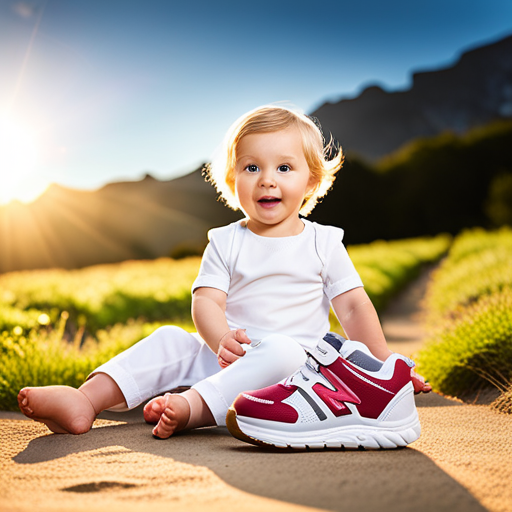
The durability and longevity of baby shoes should be carefully considered to ensure they can withstand the wear and tear of a growing walker’s adventures. When choosing the right brand for your little one, it is important to prioritize comfort and flexibility. Here are four key factors to consider when selecting baby shoes:
-
Quality Materials: Look for shoes made from durable materials such as leather or canvas. These materials are not only breathable but also provide the necessary support for your baby’s developing feet.
-
Flexible Soles: Opt for shoes with flexible soles that allow natural movement and mimic barefoot walking. This helps in developing proper balance and coordination.
-
Secure Fastenings: Choose shoes with secure fastenings like Velcro straps or adjustable buckles. This ensures a snug fit and prevents the shoes from slipping off during playtime.
-
Room to Grow: Babies’ feet grow rapidly, so it is essential to choose shoes with extra room for growth. Look for shoes with a wider toe box to accommodate their toes and allow for free movement.
Shoe Materials and Breathability

Shoes made from breathable materials like mesh and leather allow for proper air circulation and moisture-wicking, ensuring comfort and reducing the risk of foot odors and discomfort for young walkers. When it comes to baby shoes, the choice of materials can have a significant impact on foot development. Proper shoe construction is crucial to support the delicate bones and muscles of growing feet. The table below highlights some common shoe materials and their impact on foot health:
| Material | Breathability | Moisture-wicking | Comfort |
|---|---|---|---|
| Mesh | High | High | High |
| Leather | High | High | High |
| Synthetic | Medium | Medium | Medium |
| Rubber | Low | Low | Low |
Breathable materials like mesh and leather allow for air circulation, preventing excessive moisture buildup and reducing the risk of foot odors. These materials also provide moisture-wicking properties, keeping the feet dry and comfortable. On the other hand, synthetic materials and rubber tend to be less breathable, trapping moisture and heat, which can lead to discomfort and foot problems.
When choosing shoes for young walkers, it is essential to prioritize breathable materials to ensure optimal foot health and development. Proper air circulation and moisture-wicking properties provided by materials like mesh and leather contribute to a comfortable and supportive walking experience for babies. By selecting shoes made from these materials, parents can help promote proper foot development and reduce the risk of foot discomfort and odors.
Tips for Proper Fit
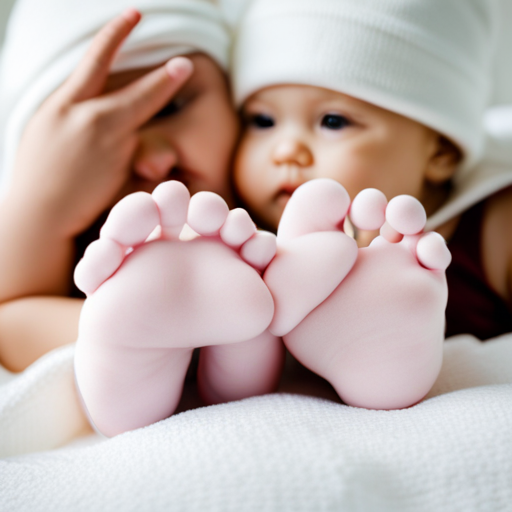
To ensure a proper fit, it is important to consider the child’s foot measurements and the size chart provided by the shoe manufacturer. Here are some tips for finding the right fit for your baby’s first walking shoes:
-
Measure your child’s feet: Use a foot measuring device or a ruler to measure the length and width of your child’s feet. This will give you an accurate idea of their size.
-
Check the size chart: Each shoe manufacturer has a different size chart, so make sure to refer to it when selecting the right size for your child. It is important to note that sizes may vary between brands, so always double-check.
-
Allow for flexibility: Baby shoes should be flexible to allow for natural movement and development of the feet. Look for shoes with soft soles that can bend easily.
-
Look for affordable options: Baby shoes can be expensive, especially when they are outgrown quickly. Look for affordable options without compromising on quality. Consider shopping during sales or looking for second-hand options to save money.
Cleaning and Maintenance
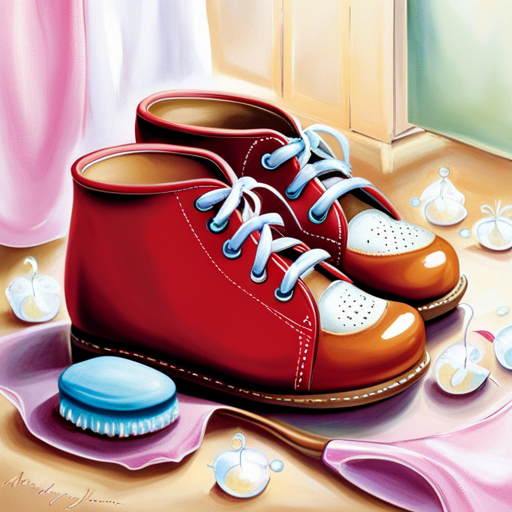
Regular cleaning and proper maintenance of baby shoes is essential for ensuring their longevity and optimal functionality. As babies explore their surroundings, their shoes are bound to get dirty and stained. To keep baby shoes looking their best, it is important to know the proper techniques for cleaning and removing stains.
When it comes to baby shoe storage, it is important to keep them in a clean and dry place. Storing them in a shoe organizer or a dedicated shoe cabinet can help protect them from dust and moisture. It is also a good idea to keep them away from direct sunlight, as prolonged exposure can cause the colors to fade.
When it comes to removing stains from baby shoes, it is important to act quickly. For fabric or leather shoes, start by gently wiping away any excess dirt or debris with a soft cloth. For stubborn stains, a mild soap or baby shampoo can be used. Apply a small amount to a clean cloth and gently rub the stain in a circular motion. Rinse the cloth and repeat as necessary until the stain is removed.
For suede or nubuck shoes, a suede brush can be used to gently lift the stain. Always remember to test any cleaning products on a small, inconspicuous area first to ensure they do not damage the material.
Budget-Friendly Options
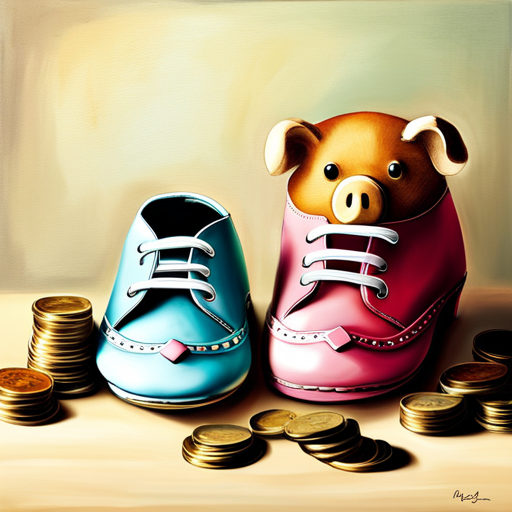
When considering affordable choices for baby shoes, it is important to explore budget-friendly options that cater to both quality and cost-effectiveness. Here are four alternatives to traditional retail options that can help you save money while still providing your little one with the necessary footwear:
-
Online marketplaces: Websites like eBay and Facebook Marketplace offer a wide variety of second-hand baby shoes at significantly lower prices than brand new ones. By purchasing gently used shoes, you can save money without compromising on quality.
-
Consignment stores: Consignment stores specialize in selling second-hand items, including baby shoes. These stores often carefully curate their inventory to ensure that the items they sell are in good condition. Shopping at consignment stores can be a great way to find affordable alternatives that are still in excellent shape.
-
Garage sales: Garage sales are another excellent source for finding affordable baby shoes. Many families sell gently used baby items, including shoes, at garage sales. Taking the time to visit local garage sales can help you score excellent deals on baby shoes.
-
Online communities: Joining online parenting communities and forums can provide you with access to parents who are looking to sell or give away baby shoes. These communities often have dedicated sections or groups where members can post items for sale or trade, including baby shoes.
Frequently Asked Questions
Are Baby Shoes Necessary for New Walkers?
Baby shoes for new walkers are a topic of debate. While some argue that they provide support and protection, others advocate for barefoot walking, citing benefits such as improved balance and muscle development.
Can Baby Shoes Hinder a Child’s Natural Foot Development?
Baby shoes can potentially hinder a child’s natural foot development due to restrictive materials and lack of flexibility. Parents should consider alternative footwear options that prioritize comfort and allow for proper growth and movement.
How Often Should I Measure My Child’s Feet for the Right Shoe Size?
When it comes to choosing the right shoe size for your child, it is important to measure their feet regularly. This ensures that they are wearing the correct size and allows for proper foot development. Consider consulting with reputable baby shoe brands for guidance.
Are There Any Specific Shoe Features to Look for to Prevent Slipping?
When it comes to preventing slipping in baby shoes, it is important to choose the right shoe material for new walkers. Look for shoes with a non-slip sole and a good grip to ensure stability and safety.
What Are Some Signs That Indicate It’s Time to Replace My Child’s Shoes?
When should I replace my child’s shoes? It is important to monitor for signs of wear and tear, such as worn-out soles or stretched out material. Additionally, regularly checking if the shoe size still fits properly is crucial for their comfort and development.
Conclusion
In conclusion, when it comes to choosing baby shoes for new walkers, it is important to consider the right size, types of shoes, benefits of soft-soled options, supportive features, stylish designs, shoe materials, and proper fit.
By prioritizing these factors, parents can ensure that their little ones are comfortable, supported, and stylish as they take their first steps.
So, step into the world of baby shoes and set your little one on the path to confident walking!


